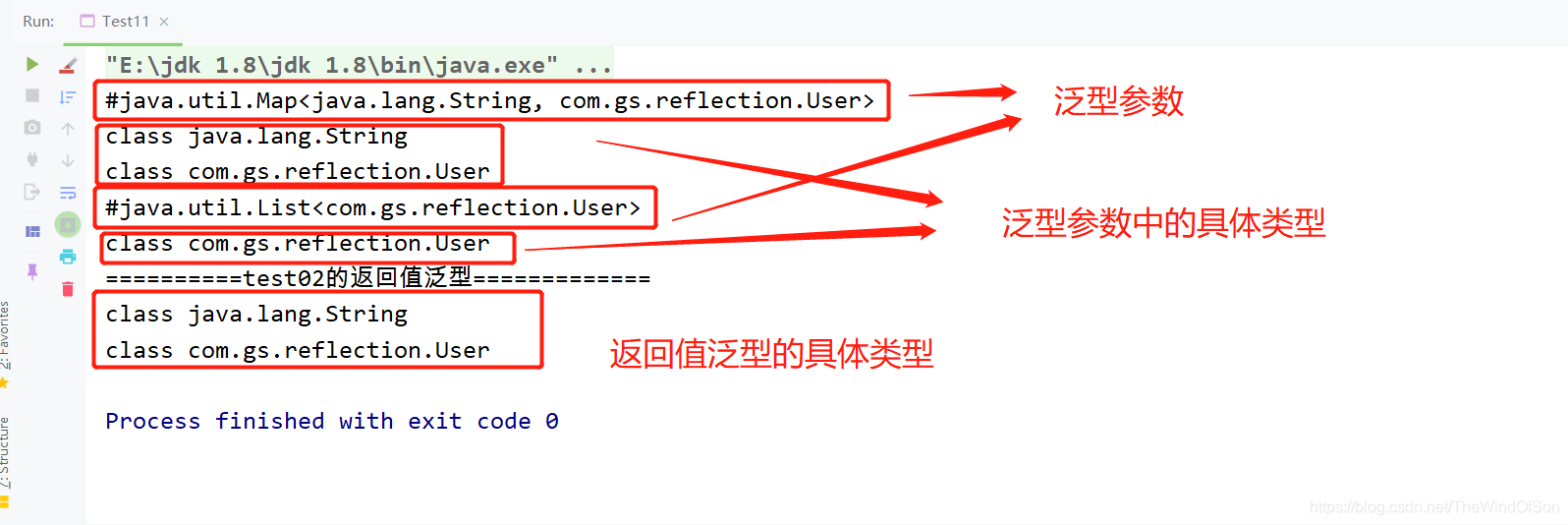1. 反射操作泛型
[1] Java采用泛型擦除的机制来引入泛型,Java中泛型仅仅是给编译器javac使用的,确保数据的安全性和免去强制类型转化问题,但是,一旦编译完成,所有和泛型有关类型全部擦除。
[2] 为了通过反射操作这些类型,Java新增了ParameterizedType,GenericArrayType,TypeVariable和WildcardType几种类型来代表不能被归一到Class类中的类型但是又和原始类型齐名的类型。
- ParameterizedType: 表示一种参数化类型,比如
Collection<String> - GenericArrayType: 表示一种元素类型是参数化类型或者类型变量的数组类型
- TypeVariable: 是各种类型变量的公共父接口
- WildcardType: 代表一个通配符类型表达式
代码示例(在开发中使用较少)
package com.gs.reflection;
import java.lang.reflect.Method;
import java.lang.reflect.ParameterizedType;
import java.lang.reflect.Type;
import java.util.List;
import java.util.Map;
//获得泛型的参数类型
public class Test11 {
public void test01(Map<String,User> map, List<User> list){
System.out.println("test01");
}
public Map<String,User> test02(){
System.out.println("test02");
return null;
}
public static void main(String[] args) throws NoSuchMethodException {
//获取指定的方法
Method method = Test11.class.getMethod("test01", Map.class, List.class);
//获取相应的外层泛型参数
// java.util.Map<java.lang.String, com.gs.reflection.User>
//java.util.List<com.gs.reflection.User>
Type[] genericParameterTypes = method.getGenericParameterTypes();
for (Type genericParameterType : genericParameterTypes) {
System.out.println("#"+genericParameterType);
//输出内层的参数
if(genericParameterType instanceof ParameterizedType){
Type[] actualTypeArguments = ((ParameterizedType) genericParameterType).getActualTypeArguments();
for (Type actualTypeArgument : actualTypeArguments) {
System.out.println(actualTypeArgument);
}
}
}
System.out.println("==========test02的返回值泛型=============");
method = Test11.class.getMethod("test02",null);
//获取相应的返回值泛型
Type genericReturnType = method.getGenericReturnType();
if(genericReturnType instanceof ParameterizedType){
//得到返回值泛型的参数
Type[] actualTypeArguments = ((ParameterizedType) genericReturnType).getActualTypeArguments();
for (Type actualTypeArgument : actualTypeArguments) {
System.out.println(actualTypeArgument);
}
}
}
}
运行结果:

2. 反射操作注解
这里我们通过一个实例来说明这个操作的应用。

- 类和表结构对应
- 属性和字段对应
- 对象和记录对应
这里我们就利用注解和反射完成类和表结构映射的关系
[1] 声明类名(相应表)的注解和属性字段的注解
//类名的注解(这里可以用来表示这个类与数据库中的哪张表对应)
@Target(ElementType.TYPE)
@Retention(RetentionPolicy.RUNTIME)
@interface TableGs{
String value();
}
//属性的注解(这里可以用来表示数据库中相应字段的属性)
@Target(ElementType.FIELD)
@Retention(RetentionPolicy.RUNTIME)
@interface FieldGs{
//列名
String columnName();
//类型
String type();
//长度
int length();
}
[2] 声明一个相应的实体类
//这里表示与数据库中的哪张表进行映射
@TableGs("db_student")
class Student2{
//声明属性中相应字段的值 ==>可以看成属性和字段对应
@FieldGs(columnName = "db_id",type = "int",length = 10)
private int id;
@FieldGs(columnName = "db_age",type = "int",length = 10)
private int age;
@FieldGs(columnName = "db_name",type = "varchar",length = 3)
private String name;
public Student2() {
}
public Student2(int id, int age, String name) {
this.id = id;
this.age = age;
this.name = name;
}
public int getId() {
return id;
}
public void setId(int id) {
this.id = id;
}
public int getAge() {
return age;
}
public void setAge(int age) {
this.age = age;
}
public String getName() {
return name;
}
public void setName(String name) {
this.name = name;
}
@Override
public String toString() {
return "Student2{" +
"id=" + id +
", age=" + age +
", name='" + name + '\'' +
'}';
}
}
[3] 我们通过一个Class类获得它相应的注解和值
getAnnotations() ===>获得所有注解
getAnnotation(注解类) ==>获得相应注解
public static void main(String[] args) throws ClassNotFoundException, NoSuchFieldException {
Class c1 = Class.forName("com.gs.reflection.Student2");
//通过反射获得注解
Annotation[] annotations = c1.getAnnotations();
for (Annotation annotation : annotations) {
System.out.println(annotation);
}
//获得注解的value的值
TableGs annotation = (TableGs)c1.getAnnotation(TableGs.class);
String value = annotation.value();
System.out.println(value);
//获得类指定的注解
Field f = c1.getDeclaredField("name");
FieldGs annotation1 = f.getAnnotation(FieldGs.class);
System.out.println(annotation1.columnName());
System.out.println(annotation1.type());
System.out.println(annotation1.length());
}
}
运行结果

以上内容是学习了狂神说java后所写
